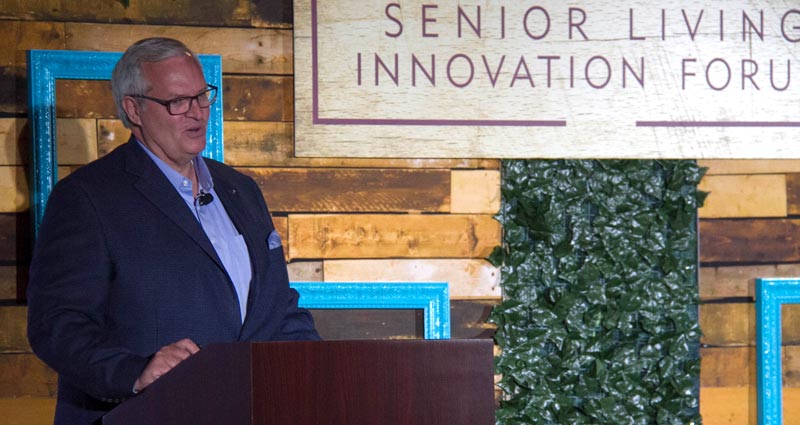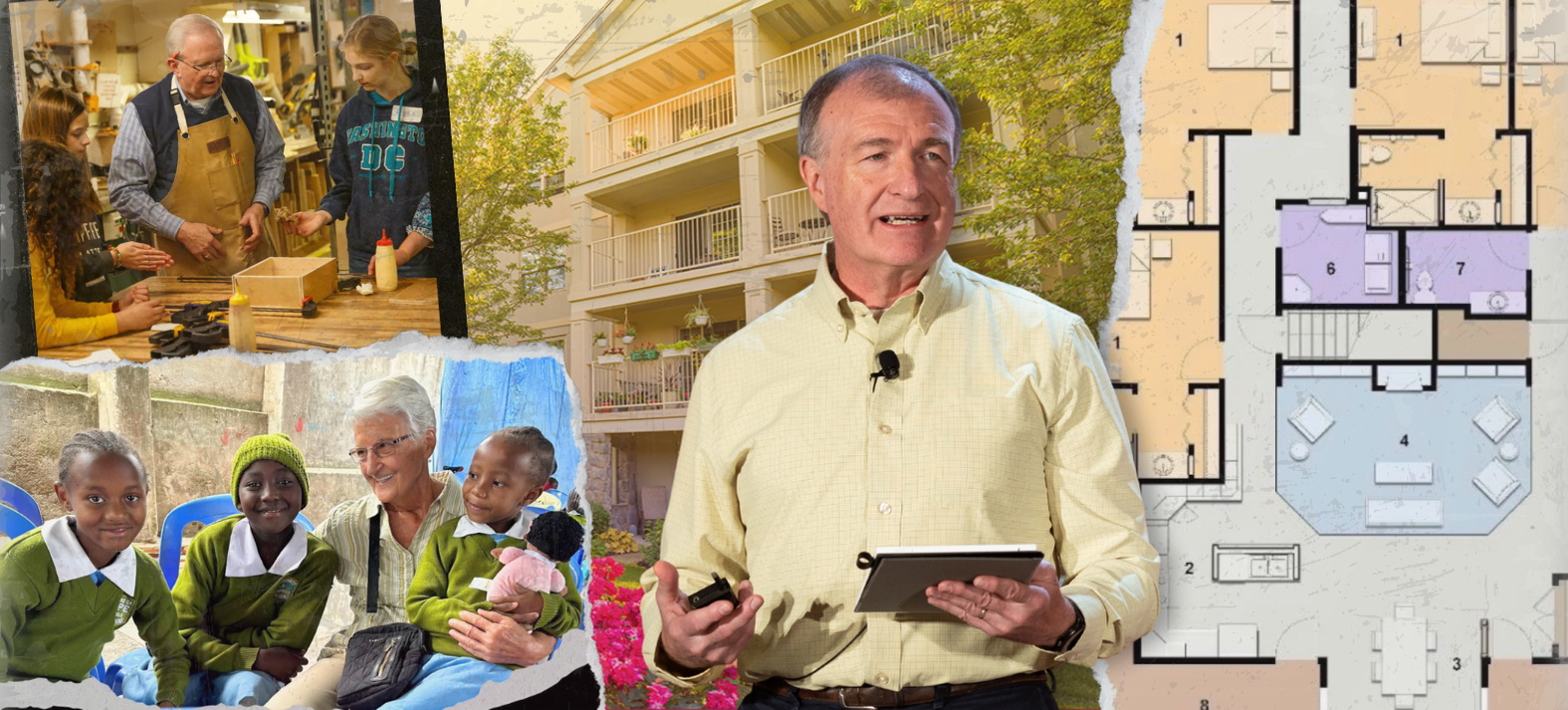Founded in 1922 as a rural children’s home, over 90+ years The Good Samaritan Society has grown into the nation's largest not-for-profit provider of care and services for seniors, with more than 165 facilities across 24 states serving over 27,000 people every day.
Good Samaritan provides a range of human services, including rehab, housing, assisted living, home and community based services. President and CEO David Horazdovsky says:
“If you can make somebody feel loved, valued and at peace, that’s our desired outcome as an organization.”
To expand its reach and better serve its (often rural) clients, beginning in 2004, Horazdovsky and his team worked with Washington, DC-based consulting firm Peer Insight to create a new design model that would help his organization reach new audiences through technology. Together they began designing the Good Samaritan’s research and innovation center, a process that continues today.
The South Dakota-based nonprofit studied people’s lives, interviewing seniors and caregivers to understand the challenges they faced. “We spent time with our consumers, studying the flow of their lives,” Horazdovsky says. Brainstorming with staff and Peer Insight consultants led to models and rounds of beta and alpha testing before taking their new platform to market.
A Diverse Team
To change the way they provide services, Good Samaritan did much more than hire a smart consulting firm and adopt a few of its suggestions. They began a far-reaching process that included collaborations with faculty at The University of Virginia, and a partnership with Volunteers of America, another large faith-based organization that provides housing, senior care and other services.
The nonprofit’s board of directors spent time at 3M and United Health, studying their models, and secured a number of large grants, including $8 million from The Helmsley Trust. They even formed an LLC and worked with Well Aware, a technology company.
“We became investors and venture capitalists, which is unusual for a non-profit,” Good Samaritan’s CEO says. “We learned that it’s not about locations, its not about brick & mortar, its how we move what we do best to where they want to be.” Good Samaritan also brought physicians groups into the model, looking for ways to support their “toughest patients” at home.
Making Connections/Eliminating Isolation
Applying what they had learned, Good Samaritan launched Vivo, which provides services for seniors and their families, and its Window to the World service, connecting isolated seniors with service providers in an initiative designed to improve quality of life and keep them in their homes for longer periods of time.
Melissa Goodwin, one of Good Samaritan’s innovation designers, describes the Window to the World platform as a tech and service solution that lets older people stay independent and connected with their communities and the larger world for longer.
Through Skype and similar video technology, Window to the World connects isolated seniors with their healthcare providers, counselors, distant family members, and social outlets—like church and quilting groups.
“Technology is enabling us as an organization to touch more lives quite frankly where we don’t have a physical presence.”
“Serving people isn’t based on location anymore.”
The Journey Continues
He believes adapting to consumer need is an enduring process. “Our journey has been an interesting time for us. We’ve enjoyed the process and by no means can I say we’ve arrived.”
The CEO lists three insights on Good Samaritan’s approach to innovation:
1. “Over 38 years with this organization I’ve learned that you need to be very clear about your vision. You need to articulate that constantly.”
2. “Where is our learning coming from? Innovation doesn’t happen within our Innovation Center, but within the margins of our organization.
3. For an organization like his to continue innovating, it needs to emphasize hiring the best talent and then listening to their input. Without smart, committed staff, “you’ll struggle.”

Horazdovsky concludes “We must work to really create a culture in which innovation occurs. Innovation is listening, it’s not talking.”
3 Keys to Staying Relevant
Older nonprofits that are open to change can not only remain relevant but even have a greater impact in a high-tech world. Here are three suggestions from David Horazdovsky, President and CEO of The Good Samaritan Society:
- Don’t be afraid to seek outside help. Over the past 13 years, Good Samaritan has sought advice from a consulting firm (Peer Insight), a tech startup and faculty at the University of Virginia, among many others.
- Study other innovation models, including corporate models. Good Samaritan board members even spent time at multinational conglomerate 3M, culling ideas from its innovation model.
- Listen to your clients and everyone on your team (including those on “the margins”) and be willing to try their suggestions more than once before moving on.
Good Samaritan Fact Sheet:
Origin Story:
The organization’s history would make a great Hallmark Channel movie. Good Samaritan’s history of great works began in 1923, when August “Dad” Hoeger, a rural Lutheran Minister, discovered Christian, a foundling with polio, on his doorstep. Hoeger took up a collection to send Christian to a hospital in Kansas City for better care; his fundraising proved so successful there was $2,000 left over, which his congregation used to build a 6-room children’s home. During the depression, an older community member “faked an injury” to gain entry to the home and Good Samaritan’s services to seniors and other communities grew from there.
The Numbers:
With its home campus in Sioux Falls, SD, Good Samaritan runs 165 facilities in 24 states across the northwest, Midwest, South and Southwest, including: Arizona, Arkansas, Colorado, Florida, Hawaii, Idaho, Illinois, Indiana, Iowa, Kansas, Kentucky, Minnesota, Montana, Nebraska, New Mexico, North Dakota, Ohio, Oregon, Tennessee, Texas, Washington, West Virginia and Wisconsin.
The nonprofit’s 21,000 employees serve 27,000 people every day. It owns 35 HUD properties, runs 50 home and community-based services locations and more than 100 senior and assisted living facilities.
A Plan for Change
Starting in 2004, The Good Samaritan Society studied what worked for other organizations and sought counsel from a range of top-flight consultants to innovate the ways in which it connected with seniors, family caregivers and other members of the (often rural) communities it serves.
An Outside Voice
Washington, DC-based consulting firm Peer Insight worked with Good Samaritan to create a new design model that better served its senior population. With a mission to “help organizations ignite growth by uniting design, business and entrepreneurship,” Peer Insight has worked with a who’s who of businesses and nonprofits, from blue chips like General Electric, UBS, Intel and Pfizer to nonprofits and organizations focused on senior services, like Good Samaritan and AARP.
Experienced Leader/Fresh Approach
A veteran nonprofit executive with an open mind, David Horazdovsky, President and CEO of the Evangelical Lutheran Good Samaritan Society, has been with the organization for almost 40 years, 13 as President and CEO.

Posted by
SLIF heads to Carlsbad!
The One of a Kind Retreat for Senior Housing Leaders.
May 31 - June 2, 2026 | Carlsbad, CA
Learn More









Comments